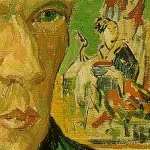I blogged a couple of weeks ago about the need for me to sit tight and wait for response to my manuscript from the readers I've given it to. Well, I'm happy to report that last week one of my readers chimed in with both gratifying encouragement and thoughtful reservations. I've been living with my Van Gogh project for so long now it's hard to keep my perspective on what works, what doesn't, what's vital, what's not. I can tell you, blog readers, that when I finally finished entering my handwritten drafts into the computer, the novel was upwards of 1250 pages. The version I sent my three readers was 830 pages: long, but 30% shorter than what I had before!The first reader to chime in was Gary McCullough, a professional speech therapist and UCA professor who also happens to be a very active creative writer. Gary has written several novels, is starting to publish his short stories, has impeccable taste in his reading, and feels as much passion for his craft as any writer I've ever met.
Gary told me something that was crucial for me to hear: He could, without difficulty, see Yellow not only being published but "big." (That's the kind of determination you can never make about your own book, so I appreciate Gary's confidence.) On the other hand, he had questions about the conflicts that occupy the last third of the book, when my Van Gogh character--as Van Gogh did in real life--has essentially broken from his family, except for his brother Theo, and commits himself to living the life of a painter in a foreign country. Previous to this point, and especially while his father is alive, Van Gogh struggles mightily against his own family (who regard him as a failure), and against his own uncertainty as to his vocation. Once he moves from Holland, conflicts with his family retreat to the background. (His father, at this point, has passed away.) What I try to show in my novel is that Van Gogh's main conflict from that point on was with his ability to realize the paintings he saw in his mind's eye.
This is not to say that the Van Gogh had no interpersonal conflicts in the last 5 years of his life. Hardly. In fact, his extremely complicated relationship with Paul Gauguin--a third resentful of him, a third suspicious, and at least a half worshipful--became the most dominant and problematic relationship in his life; previously that designation had belonged to his relationship with his father. In my novel, you can't miss Gauguin's presence in the latter chapters. Even so, it is Van Gogh's conflict with paint that dominates the last third of my book, and it's my challenge and my duty, Gary seems to be saying, to make that as vital and engaging a conflict as the earlier one with his family. I agree. Thanks for the input, Gary.
Wednesday, February 24, 2010
Subscribe to:
Post Comments (Atom)













0 comments:
Post a Comment